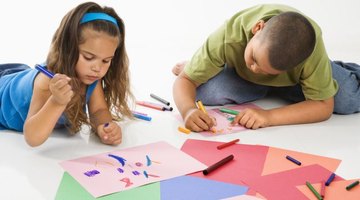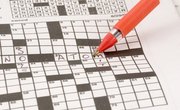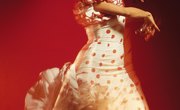Glyphs are an effective way for young students to practice and improve their communication skills without actually having to write. Glyphs are symbols that convey information. They can be simple or elaborate. Often, they are homemade. Glyphs can be used in every subject, and can be done individually or as a group. Use them with kindergartners to convey and analyze data, and as a way for students to share information about themselves.
Name Glyphs
Instead of making name tags for your students at the beginning of the year, have them create their own name glyphs. Distribute blank name tags, or fold a piece of heavy paper lengthwise for students to create their own. Tell the students to write their name in black if they are the oldest child in the family, red if they are a middle child, blue if they are an only child and green if they are the youngest child. Then, have them add a symbol for the month they were born. For example, students born in February might add a heart next to their name. Next, have them create a line of dots at the top or bottom of the name tag to signify their birth date. Finally, ask your students to create a colorful border to show if they have siblings at home. For example, students with no siblings would not draw a border, students with one sibling would draw one line around their name, and students with two siblings would draw two lines. Tape the name tags to the desks and encourage the students to look at them to learn more about each other. Post a key to the glyphs at back-to-school night so parents can decode them.
Shape Glyphs
Create a "glyph monster" and review the shapes and colors at the same time. For the body of the monster, ask the students to select their favorite shape in their favorite color. Cut several different shapes, of different sizes, out of colored construction paper ahead of time. Have the students glue the body onto a piece of paper. Then, ask them to add eyes. You can make these in advance or have the students draw the eyes onto the body shapes. Tell them to add one eye if their shape has no sides or has three sides, or they can use the words "triangle" and "circle." If their shape has four sides, such as a rectangle or square, they are to add two eyes. Boy monsters get an oval mouth and girl monsters get a half-circle. Finally, have each student glue white triangular teeth to the monster's mouth -- one tooth for every year of age. Then, display the monsters and analyze the data together with the class. For example, ask the class to count and tell you how many students picked "triangle" as their favorite shape. Write the answers on a dry-erase board or large piece of paper.
Family Glyphs
Family glyphs are an excellent way to get to know your students better. They also are a good starting point for discussions about how all families are different in some ways but alike in others. First, create a key for the glyph by choosing a different color for each family member. For example, white might stand for the student; blue might stand for father; pink for mother; purple for grandmother; green for brother and red for sister. Then, cut out several small shapes such as squares or circles in each color. Place the shapes in several baskets and put a basket at each table or group of desks. Next, distribute large hearts or pieces of paper shaped like houses to each student. Have the students select the pieces of colored paper to show who lives with them in their houses, and then glue these pieces of colored paper onto the houses or hearts. For example, a student who has two brothers and lives with his mother -- but not his father -- might glue one white square, two green squares and one pink square onto his house. Then, let each student share his family with the class, and analyze the data on a chart or graph.
Pizza Glyphs
Have the students create their own pizzas out of paper by making pizza glyphs. Each paper "topping" will stand for something, depending on your legend. Use brown construction paper or cardboard circles for the pizzas. Then, have the students glue the colorful toppings on the pizzas. For example, you might choose red circle "pepperoni" pieces to symbolize pets. A student with three pets would put three circles on his pizza glyph. Then, ask the students to add olives -- small black ovals -- to the left or right side of the pizza, depending on if they are left or right-handed. Finally, add triangular yellow pineapple pieces to represent a student's age or the number of siblings that student has. See if the students can answer questions about the pizzas, such as who has the most pets and the number of people who are right-handed compared to those who are left-handed. Finish with a real pizza lunch.











